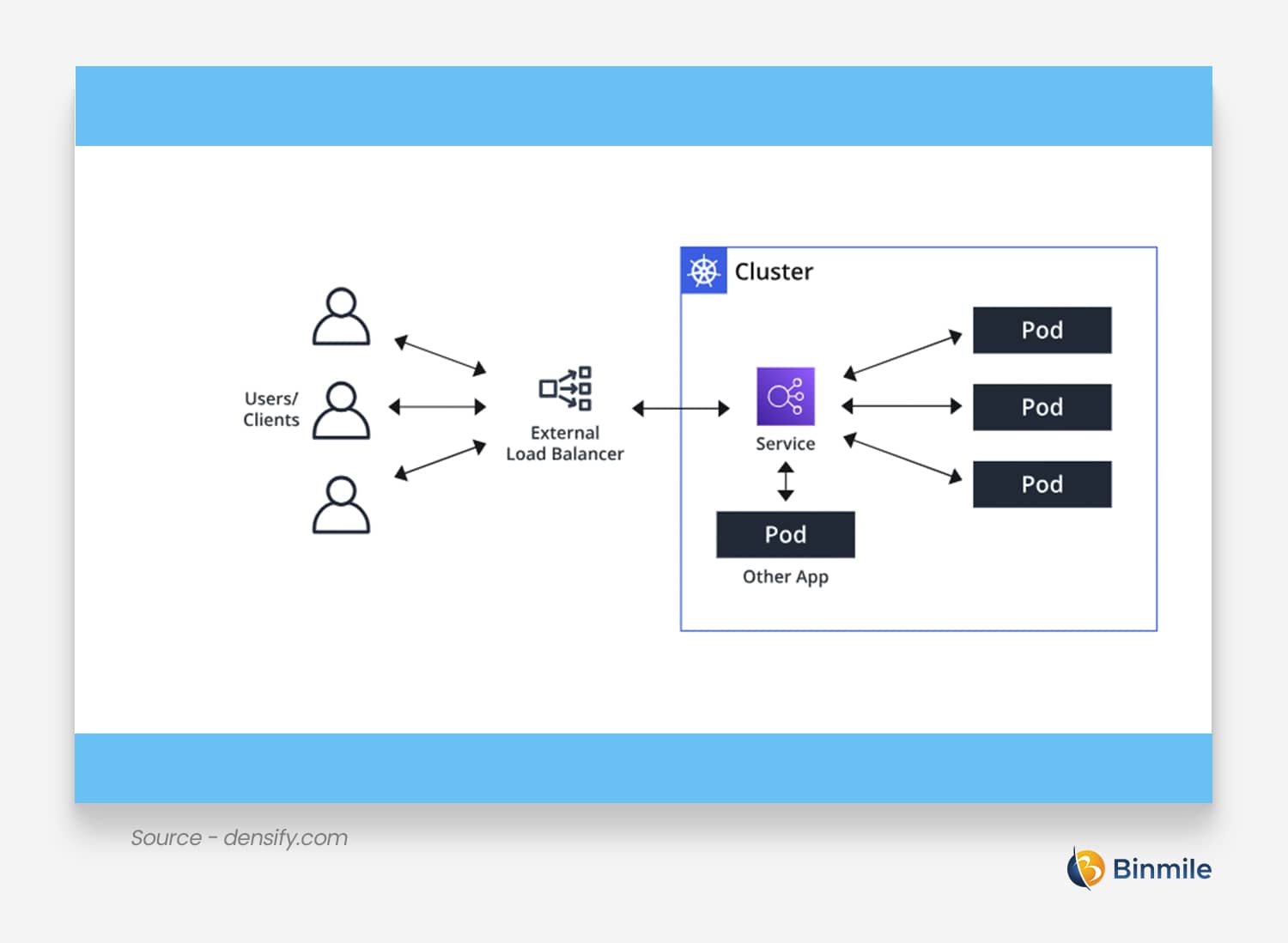In Kubernetes (a container orchestration platform), the term “Service” defines an exposure of a network application functioning as one or more deployable units of computing (called Pod).
Here, we are discussing Kubernetes services, their types and related details in this write-up.
Kubernetes Services Explained
Kubernetes services are defined as an abstraction, representing a set of logical pods or a deployed group of ephemeral pods in a cluster. It ensures the availability of pods providing specific functions. For example, image processing or web services, with assigned name and unique IP address called ClusterIP.
Pods are accessible using that IP address and DNS name. The service remains unchangeable as long as it uses the IP address. Any service-related requests get redirected to the relevant pods, making the service as an endpoint to application communication. It helps pods scale easily.
How is a service different from a deployment in Kubernetes?
A deployment ensures continuous functioning of pods. To say otherwise, it keeps a group of pods functional.
You could rule out a service when using a deployment to keep a set of identical pods running in the cluster. In addition, developers can also scale up and down the deployment.
A service is used to enable accessibility of a network to a set of pods. To use a service without a deployment would require creating each pod individually to route network requests to the pods by selecting them according to their labels.
Technically speaking, a deployment helps launch a pod with containerized applications, ensuring continuous function of replicas on the cluster.
A service exposes an interface to the pods facilitating network access from within the cluster or enabling network access between external processes and service.
Types of Kubernetes Services
Kubernetes services contain four distinct types, each suitable for executing specific tasks. We have detailed each type of service as follows.
ClusterIP
ClusterIP seeks to function as a type of service exposing instances of pods (each with a unique ID address) that run on the cluster. The IP address, assigned uniquely to each pod, is used by the ClusterIP service, enabling routing traffic to and from the pod. Interestingly, Kubernetes can automatically create a ClusterIP service if a specific attribute in the YAML file is not specified.

ClusterIP Service in Brief –
- An equal distribution of network traffic (also called load balancing) to a group of identical pods
- Exposing instances of pods running on the Kubernetes cluster
- Assigning a unique IP address and DNS name to a set of pods to be leveraged by other services within the cluster
NodePort
Identical to a ClusterIP service, NodePort is defined as an extension of the ClusterIP service type.
You can also say it builds on top of the ClusterIP service, exposing a group of pods via a static port on each node’s IP to an external world, allowing communication with each other. Each pod contains one or more ports being used as an external IP address used by clients connecting to it.
Security becomes a point of concern when NodePort is used to expose ports. Reason? Anyone familiar with the IP address of a node in the cluster can access the resources running on the node.
As a result, it may be counterproductive, like manipulating the services and associated data by unauthorized users.
LoadBalancer
Load balancer maintains reliability and scalability of network performance by distributing network traffic among servers or nodes in a cluster. Based on your needs, you can use load balancer to add or remote nodes.

Moreover, there are many options for load-balancing external traffic to pods.
Also, LoadBalancer services in Kubernetes ensure that traffic is automatically routed away from unhealthy pods, ensuring availability and responsiveness of the service anytime.
Load balancer is an extension of NodePort service exposing a resource on a specific pod on each node in the cluster.
Headless Server
Headless service in Kubernetes doesn’t randomly issue requests or needs load balancing. It rather ensures direct communication between a specific pod and other pods. It accomplishes this task by specifying the ClusterIP of the pod to “none” and running a DNS lookup to discover the pod’s IP.
What defines headless services is selectors which enable them to create endpoint records. The use case of headless service is involved when accessing databases, or similar stateful applications.
ExternalName
The ExternalName service in Kubernetes is useful when you have a service running outside or inside the cluster, enabling access to it from within the cluster. It acts as a proxy, mapping specific service to a DNS name, and allows redirecting the requests to a service running outside or inside the cluster.
The ExternalName service in Kubernetes has its great significance. You see, when it comes to migrating applications to Kubernetes, it involves retaining an external database so that you can use it to retrieve data using new Kubernetes.
However, your pods can’t spot the database residing outside the cluster. This is where ExternalName service helps by helping developers retain the external database.
Read more – Detailed Review Of Cloud Automation Tools
Why is it necessary to configure Kubernetes services?
Services in Kubernetes must be configured properly.
If not, you may run into the following issues –
- It would be difficult for the containers within the pod to communicate with each other properly
- Required access to the resources would be difficult for pods. For instance, they would probably won’t access to memory, CPU, or storage
- It would induce performance paralysis for your application reaching the outside world. For example, accessing external services would be difficult with the app.
- Possibility of poor performance of the Kubernetes cluster down the line, thus affecting the reliability and scalability of apps running on it.
Therefore, pay attention to how you set up services in Kubernetes. They contribute significantly to ensuring consistent performance of your application. Improperly configured services in Kubernetes may result in disrupted communication among prods, thereby harming the performance of your applications.
Also Read : POD models in software development.
Winding Up
The role of services in Kubernetes is significant. They ensure steady provisioning of a network endpoint meant for a set of pods, resulting in simplified communication between apps. This write-up gives you an exclusive insight into how to create and use services in Kubernetes, encompassing the most common Kubernetes services, such as:
- ClusterIP
- NodePort
- LoadBalancer
- Headless
- ExternalName
Understanding these Kubernetes services are essential and can benefit you greatly if you know how to correctly configure them for effective cluster communication.









